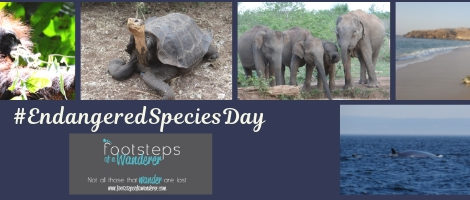
Up close with endangered species
I wanted to write a post around #EndangeredSpeciesDay, conscious that I am to be lucky enough to have seen a number of endangered animals in their natural habitats. It’s taken a long time to write however; as I researched this year’s Endangered Species list, I got sucked in to article after article about different species, all of which are suffering in some way due to human activity. I wanted to be positive however, and think about some of the ways we can help conserve these animals and ensure that they can be appreciated in the wild by our children…
So the numbers… According to the IUCN (The International Union for Conservation of Nature)’s Red List of Threatened Species, more than 27,000 species are threatened with extinction – more than 27% of all assessed species. (In case you’re interested, that’s 40% of amphibians, 34% of conifers, 33% of reef building corals, 25% of mammals and 14% of birds).
I would be here forever if I tried to write about them all, so I am going to focus on those which I have had the privilege of seeing in the wild for myself:
Turtles
All sea turtles are threatened with extinction, but the Hawksbill is the closest to the brink, listed as critically endangered on the IUCN list, followed by the Olive Ridley and Leatherback. The Leatherback is listed by the IUCN as vulnerable, yet many subpopulations are facing extinction.
In the past 100 years, the Hawksbill Turtle has lost 90% of its population, 80% of which has been lost in the past 10 years. The Hawksbill grows slowly and breeds rarely, which, coupled with human hunting, has driven the species to the brink. The Leatherback turtle is listed by the IUCN as vulnerable, yet many subpopulations are facing extinction.
The tortoiseshell trade, collection of their eggs for food, and destruction of coral reefs have all contributed to their declining numbers.
I’ve seen these gorgeous animals up close all over the world, while diving and snorkelling in Borneo, Australia, Fiji and here in the UAE and Oman, hatching at a turtle sanctuary in Sri Lanka and on the beaches of the reserve at Ras Al Jinz, Oman, as well as through the amazing work of the Dubai Turtle Rehabilitation Project here in Dubai, which I’ve written about previously here.
Diving has afforded me the chance to observe many endangered and vulnerable species without disturbing them, from humphead wrasses (including one affectionately named Elvis in Australia, which may be the biggest fish I’ve ever encountered in the water!) to sharks, dolphins and whales.
Orangutans
All three species of orangutans – the Sumatran, the Bornean, and the recently discovered Tapanuli – are critically endangered, with around 60,000 surviving across all three species.
Approximately 80% of the population has been lost in the past 75 years, mainly as a result of mass deforestation. Bornean orangutan numbers have been more than halved in the past 60 years, mainly due to deforestation as humans encroach on their habitats.
One of my all time favourite experiences was seeing orangutans in the Borneo rainforest, both in the wild, and at the final stages of rehabilitation in the Sepilok Orangutan Rehabilitation Centre. I chose my rainforest tour and jungle lodge carefully to ensure it was ethical and eco-friendly, and we were rewarded with some great sightings of orangutans from our river and walking tours.
Here, we were also very lucky to see the critically endangered Borneo Pygmy Elephant, seen hiding in the long grass in the distance from a riverboat, it was incredibly difficult to spot and a rare privilege.
Galapagos Giant Tortoises
Galapagos giant tortoises are divided into 15 species, 11 of which survive today. The tortoise populations on all the Galapagos Islands were decimated after humans arrived and began loading them onto ships for their meat. They also brought animals such as rats, which prey on young tortoises, and goats which destroy their habitat.
The plight of the giant tortoise was brought into the spotlight several years ago when the public fell in love with Lonesome George, the last of his Pinta Island saddleback species, and who died in 2012. However, there is some good news that a new species of Saddleback Tortoise has been found on Isabela Island – a hybrid of those that were extinct.
I can’t believe I still haven’t written a post about our trip to The Galapagos (watch this space, coming soon!) Here we were incredibly lucky to see so many animals listed as endangered or vulnerable, including the Galapagos penguins (we actually snorkelled with one of these little guys), marine iguanas, sea lions, seals and sharks. Human visitation has strictly limited numbers, and it was incredible to see how fearless these creatures were of us as a result – and clear to see how easily they could be negatively impacted without these controls and education.
Sri Lankan Elephants
Sri Lankan elephants are one of three recognized subspecies of the Asian elephant, and native to Sri Lanka. Since 1986, Elephas maximus has been listed as endangered by IUCN as the population has declined by at least 50% over the last three generations, estimated to be 60–75 years. The species is primarily threatened by habitat loss.
If you follow my blog, you’ll know I love Sri Lanka and have been three or four times now. The Sri Lankan elephant population is now largely restricted to the dry zone in the north, east and southeast of Sri Lanka, and I have been lucky enough to see them in Udawalawe National Park as part of the Lanka Challenge tuk tuk adventure, and recently in Yala National Park, which I will be writing about soon as a recommended long weekend break from Dubai.
Whales and Dolphins
Whales are at the top of the food chain and have an important role in the overall health of the marine environment. However, six out of the 13 great whale species are classified as endangered, even after decades of protection.
Collisions with ships, getting tangled in fishing gear, and pollution pose a huge threat to whales, as well as commercial whaling which is still undertaken in some countries. In addition, shipping activity and oil & gas development cause noise that can damage whales’ hearing, which puts them off their feeding and breeding grounds, and disrupts their migratory paths, as well as changes due to global warming.
When visiting Canada a couple of years ago, I made a crazy road trip from Toronto up into Taddousac in Quebec, just to try and get a glimpse of some of these beauties in their natural habitat. The blog post is coming soon, but suffice to say it was well worth the trip. I chose an eco-tour which meant we kept a long distance from the whales in our boat, but still managed to spot the critically endangered fin whale, blue whale and humpback whales, knowing we weren’t damaging them.
I’ve actually been fascinated with dolphins and whales since my childhood, and was delighted to swim with wild dolphins when backpacking Australia many years ago – choosing to pick an eco tour that doesn’t interact with dolphins, and whilst that meant they couldn’t guarantee sightings, we were particularly lucky to see several pods and a mother with baby. We also frequently see dolphins in the waters of the Musandam in Oman, and there are vulnerable dugongs off the coast of Abu Dhabi (not that I’ve ever seen them)
So how can we help?
There are some simple things we can do at home, and when travelling to these sensitive places that are the home to endangered species:
1. Buy sustainable, organic products
Check the labels of the products you buy, make sure they only contain sustainably-sourced palm oil or an alternative (this is responsible for a lot of the deforestation in Borneo and Indonesia in general) and make sure fish products have been produced through sustainable fishing (not using trawl nets which hurt turtles, whales, dolphins and all number of fish). Try to get organic toiletries which won’t have such a negative impact on water sources.
2. Reduce the use of chemicals
Don’t use pesticides or fertilisers in your gardens that contain harmful chemicals, If you’re going swimming in the sea, use organic sunscreens and avoid perfumes and sprays which could be toxic for marine life.
3. Recycle, reuse, reduce
We all hear this enough, but do we do it enough. We need to reduce the amount of packaging, bags, clothes, etc that we use, reuse as many things as we can, and recycle rather than throw out.
4. Reduce water consumption
Turn off the taps! Don’t leave it running while you brush tour teeth, don’t run the shower for ten minutes before you get in. Simple changes that could make a huge difference to our planet.
5. Avoid plastic
There has been so much of a focus on this in the last couple of years, we’re all aware of how much of an issue plastic is, and with so many natural alternatives on the market now, it’s much easier to make the switch.
5. Leave only footprints
It may be obvious to most of us that we need to clear up after ourselves, take our rubbish away and dispose of it properly, but some people may not be as aware of the environmental impact of their litter, so if you see other people’s rubbish – pick that up too!
6. Be careful with your souvenirs
Don’t buy gifts or mementos that support black market trade or threaten the environment, particularly anything made of coral (those pretty red necklaces in tropical locations are probably coral), ivory, or tortoise shell.
7. Be an ethical tourist
Very importantly, choose your experiences wisely. Research those tours that offer animal interaction – do you really want to stroke drugged up tigers kept in small concrete cages, or watch elephant shows or ride elephants that are treated badly with bullhooks and sticks, and kept chained up, or swim with dolphins/sharks/whales that are fed or otherwise have their natural life interfered with in a way that impacts their breeding/feeding patterns? Likewise, do you want to stay in a hotel or travel on a boat that pollutes the environment, or gets too close to the animals and harms them.
8. Educate others
A much more holistic, longer term solution, but one that could have the most impact. Wherever you go, talk to people and educate them about the impact of human activity on the environment, when you give feedback to hotels, make suggestions about ways of becoming more eco friendly. Most importantly of all, educate your children and those around you about the importance of the environment and endangered species, so that they might get a chance to see them.
9. Volunteer
There are so many ways you can generously give a little of your time to help, whether by supporting a charity or organisation and volunteering in the offices or fundraising events, or more directly by participating in clean-up’s (I’ve taken part in several desert and beach clean up’s and even one underwater as a diver here in Dubai, and even helped with a clean up with in Deir Estiyah in Palestine while travelling there).
Out of Africa
I’m hoping to head to Africa next year for a bucket list trip, and would love to hear recommendations of eco friendly, sustainable tours and hotels while I’m there. The continent is home (for now) to a number of endangered and vulnerable species, which I would love to try and see, including gorillas, chimpanzees, rhino, elephants, hippos and leopards, but I want to make sure that if I do so, it is without negatively impacting their existence.
A story of hope from the Middle East
I wanted to finish this piece on a high, and found a fantastic story of hope amongst my research – close to home too…
The Arabian Oryx was previously hunted (mostly for trophies) until it became extinct in its native range in the Middle East in the 1960s, with the IUCN officially classifying it as ‘extinct in the wild’. However there were Arabian oryx held in private reserves and zoos around the world and reintroduction efforts began in 1980. By 2011, there were more than 1,000 living in the wild, and the IUCN then reclassified its conservation status as ‘vulnerable’. This significant change made it the first animal to ever revert to a vulnerable listing after being classified as extinct in the wild.
So there is hope, we just have to do all we can to ensure other species don’t get to this state. Let me know any other ideas or recommendations as I’d love to share more here…
















